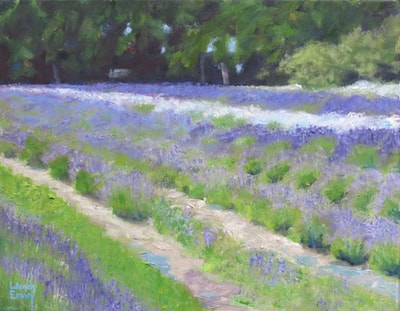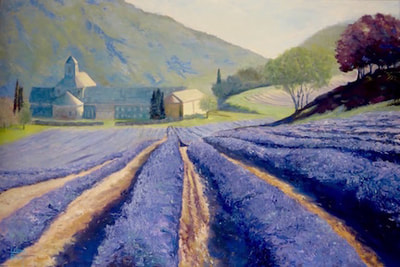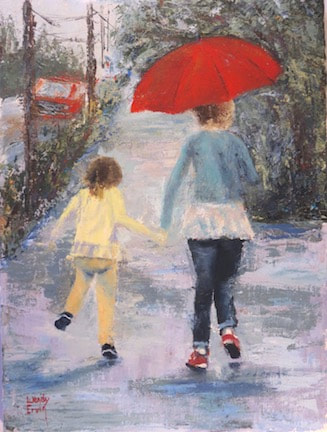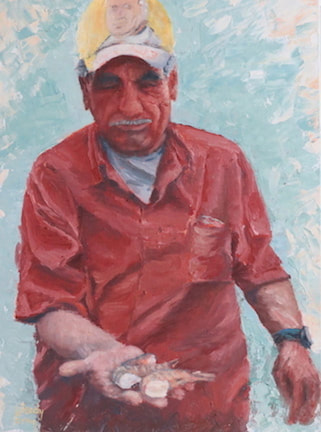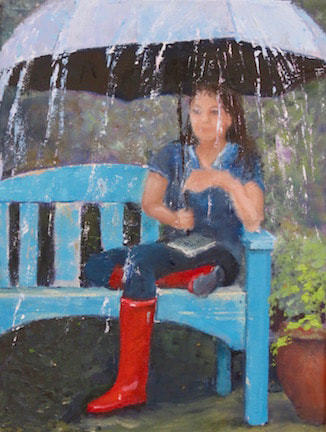|
What is it that makes one painting more compelling, more engaging, than another? Sometimes it's the most simple element of composition that takes a painting from "meh" to "wow"...the Line. Whether it's curved or straight, thick or thin, short or long, it is the Line that leads our eye and our attention. When you are looking at a painting, locate the ways lines have been used and notice how they lead you into the subject. Often the most dominant lines will take your eye right to the focal point or main idea. The angle of the line is important, too. A strong vertical or horizontal line can disrupt the flow of a painting, even taking the viewer right out of it. That may be the reason you have walked right past gallery paintings without know why. Not only did the use of Line not draw you in, but that strong horizontal horizon line pointed you to go on to the next painting! A sloping line, as in a hillside or tree shape, really helps to gently direct your attention in and around the subject. There are often many lines in one painting: soft natural flowing lines that move your eye around the scene, harder and sharper ones that define structure, bold vertical lines (maybe a tree or pole) near the edge of the picture plane to stop your eye from leaving the scene. Look for that last example and see how it kept you engaged a little longer; maybe long enough to feel what the artist is trying to communicate. Lines can also be hidden in ways that are less obvious to the viewer. When you look at a figurative painting you aren't likely to think of a leg or arm as Line, but consider how the figure may be positioned so that your eye follows the line of gesture up and into the focal point. Lines may also be disguised in color or value, as in a field of grass, a cloudy sky, or a turbulent seascape. Even the directional paint strokes the artist uses can contribute subtle lines that make the painting successful.
In my previous blog I wrote about irregularity and variety in pattern; this one has been about lines and angles; stay tuned for another one coming soon...all intended to help you enjoy and create interesting and delightful art. Thanks for reading!!
6 Comments
Janet Walker
3/15/2018 02:11:39 pm
Interesting as always.
Reply
Wendy
3/19/2018 06:38:02 pm
I always appreciate your encouragement, Janet!
Reply
Gay weidkamp
3/15/2018 08:04:24 pm
You are a really good teacher. I am learning a lot and you are helping me to study the paintings in galleries and determine why I like them. Thanks Wendy for bringing art into more of our lives.
Reply
Wendy
3/19/2018 06:39:52 pm
Thank you, Gay...you are an enthusiastic learner! And you really apply the info into your life experiences...like all the awesome galleries in Arizona!
Reply
K Foster
3/19/2018 11:12:04 am
thanks for sharing your knowledge. Glad you participated at Artsclamation
Reply
Wendy
3/19/2018 06:40:35 pm
Thank you for reading, Kathy...it's nice to be in touch with you.
Reply
Leave a Reply. |
Hello! My name is Wendy and I am passionate about oil painting! Whether in the studio or out in Mother Nature, I get lost in the experience of capturing on canvas the moment and the feel of what I am painting. I pour my love and energy into every single piece of artwork and I hope it shows! This blog is a place where I can use words to talk about art, painting, life, faith, things that make me laugh, and things that inspire. I love every response, so don't be shy about leaving a comment...Archives
June 2024
Categories |
